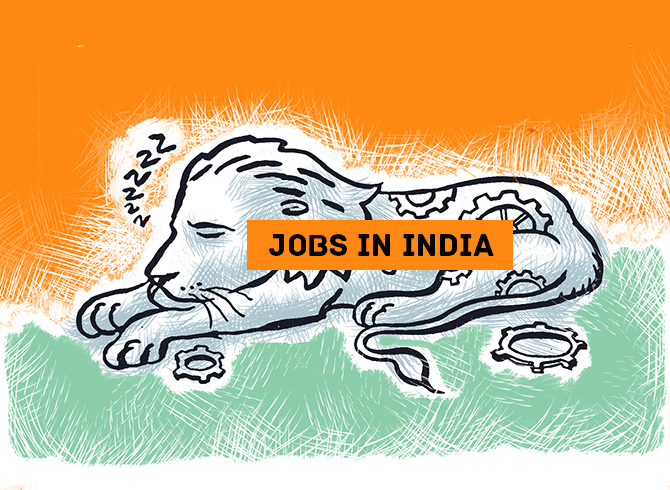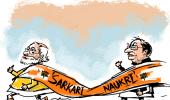Most economists were of the view that the NSSO should release the data, as any move to withhold it will dent the image of country’s statistical system.
Illustration: Dominic Xavier/Rediff.com

Economists have urged the government to immediately release the National Sample Survey Office’s (NSSO’s) periodic labour force survey (PLFS) report, which showed the unemployment rate climbing to a 45-year high of 6.1 per cent in 2017-18, without any changes in the results.
NITI Aayog Vice-Chairman Rajiv Kumar chaired an informal meeting with some economists and experts on February 21 to discuss the NSSO report, sources aware of the meeting said.
Chief Statistician Pravin Srivastava gave a presentation on the NSSO report’s findings, methodology, sampling design, among others, to the experts and sought their views on it.
“Most economists were of the view that the NSSO should release the data, as any move to withhold it will dent the image of country’s statistical system,” said a person who attended the meeting.
Some experts opined that the government should focus on releasing the administrative data produced by the Employees’ Provident Fund Organisation, among agencies, to give a picture of employment in the country, the person added.
NITI Aayog Chief Executive Officer Amitabh Kant, former Prime Minister Economic Advisory Council member Surjit Bhalla, former chief economic advisor Arvind Virmani, Indira Gandhi Institute for Development Research Director and Vice-Chancellor S Mahendra Dev, Research and Information System for Developing Countries Distinguished Fellow Amitabh Kundu, Manipal Global Education Chairman T V Mohandas Pai, among others, attended the meeting.
“The NITI Aayog wanted to know if there were any loopholes in the survey report. But most were of the view that the data should not be altered and the report should be released in the present form, so that experts can do a proper analysis of the unit level data of the survey,” another person, aware of the meeting, said.
The NSSO is preparing a note on the changes in the sampling frame which took place in the PLFS, compared to the previous surveys on employment and unemployment, a Ministry of Statistics and Programme Implementation (MoSPI) source said.
The note will be referred to the standing committee on labour force statistics, which had given approval to the report in its meeting held on December 4.
“A note may be added in the report citing the changes in the sample frame in the present report, compared to the previous reports of the NSSO and the impact of any methodological changes on the survey’s results,” a third person, aware of the meeting, said.
However, an economist pointed out in the meeting that the figures in the PLFS can be compared with the previous NSSO reports, another source said.
Since the meeting was informal, no agenda and minutes of the meeting were circulated, the source added.
The NSSO’s PLFS report was approved by the National Statistical Commission (NSC), the apex independent body on data, in its meeting held on December 5.
The NSC had told the government to release the report.
However, the report, which has been termed as a ‘draft’ by the government, hasn’t been made public so far.
Two members of the NSC, including its acting chairman P C Mohanan, cited displeasure over the government’s move to withhold the data as one key reason behind their resignation.
Business Standard reviewed a copy of the report which showed that the unemployment rate stood at 6.1 per cent in 2017-18, compared to 2.2 per cent in 2011-12.
Sources said that the MoSPI had even held a meeting with the labour and employment ministry in December to know whether the broad trend seen in the PLFS matches with that of the data produced by the labour bureau on employment and unemployment for 2016-17.
The labour bureau’s data showed unemployment rate jumping to a four-year high of 3.9 per cent in 2016-17.
However, despite Labour and Employment Minister Santosh Gangwar’s approval, the labour bureau’s data has also been withheld.











